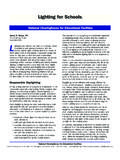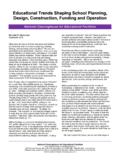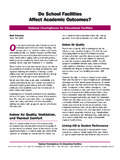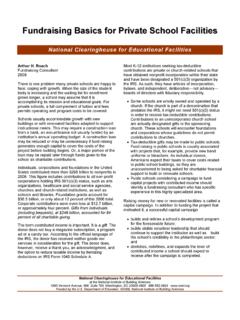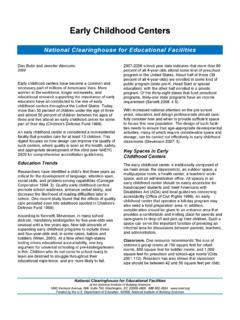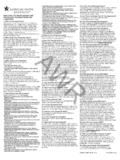Transcription of Door Locking Options in Schools - NCEF
1 DDoooorr LLoocckkiinngg OOppttiioonnss iinn SScchhoooollss National Clearinghouse for Educational Facilities National Clearinghouse for Educational Facilities at the National Institute of Building Sciences Prepared under a grant from the Department of Education, Office of Safe and Drug-Free Schools 2009, National Institute of Building Sciences doors as Means of Egress doors serve a variety of needs and purposes in Schools : Exterior doors provide building security and protection from the elements. Interior doors control the movement of people among school spaces, help control noise and air flow, and act as flame and smoke barriers during a fire. In a lockdown, they serve as safety barriers.
2 From a security perspective, the most important function of a door is to control entry. Entry control involves the configuration, strength, durability, and composition of the door, its hinges and its frame, and the control and effectiveness of its latching and Locking hardware. From the standpoint of fire safety, however, a door s exit function is the ruling factor, one that is highly regulated by building and fire codes that classify doors as part of a building s means of egress. Means of egress is defined as a continuous and unobstructed way of travel from any point in a building or structure to a public way 1 that is, it is the unobstructed route from inside every school classroom or space to outside the building.
3 An egress door is any door along this egress route. In occupied buildings, egress doors can prevent entry but they can never prevent exit. This iron-clad rule is the product of over a century of fire safety regulation, molded by numerous tragic and sometimes horrendous building fires, and refined by decades of research and experience. Its success is evidenced by the fact that fire deaths in Schools are Egress doors are regulated by the following building and fire code provisions: International Building Code (IBC), 2006 edition, and the International Fire Code (IFC), 2006 Edition:3 Section Egress doors shall be readily openable from the egress side without the use of a key or special knowledge or effort.
4 National Fire Protection Association s Life Safety Code (NFPA 101), 2006 edition:4 Section doors shall be arranged to open readily from the egress side whenever the building is occupied. Section Locks, if provided, shall not require the use of a key, a tool, or special knowledge or effort for operation from the egress side. Section Key operation shall be permitted, provided that the key cannot be removed when the door is locked from the side from which egress is to be made (per Sections and , New and Existing Educational Occupancies). In addition to the these requirements, fire and safety regulations mandate that doors in spaces that can be occupied by more than 50 people (usually 1000 square feet) must be equipped with panic This applies to any large space in a school , and to the school itself.
5 Exterior doors The need for unrestricted egress to the outside poses problems for all building types, but especially Schools because it makes it easy for students to let others inside. There are many stories about school staff illegally chaining exit doors shut to keep out strangers and contraband. As dangerous as this practice is, one can empathize with school administrators trying to balance competing safety concerns. 2 Door Locking Options in Schools National Clearinghouse for Educational Facilities at the National Institute of Building Sciences Prepared under a grant from the Department of Education, Office of Safe and Drug-Free Schools 2009, National Institute of Building Sciences For Schools with automatic sprinkler systems, a partial solution to this problem is the use of delayed egress locks that sound an alarm when panic bars are pushed and delay door opening for up to 15 Most Schools do not have sprinklers, however, so this solution has limited application.
6 In addition, the time delay may be detrimental in situations where a very rapid exit is necessary. Access-controlled egress doors are permitted in all Their latches can be electronically controlled from the reception area or school office. Such doors must be readily opened by a push from the inside and meet a number of other safety requirements. They cannot include delayed egress locks, but otherwise may be installed in virtually any school . Supplemented by an intercom, and by a security camera when the entry is not visible from the reception area, they are an excellent entry control device. Electronically-controlled keyless door locks are available as hard-wired (usually networked) and wireless, stand-alone models.
7 The latter can cost considerably less when retrofitting. Hard-wired models, however, are superior when it comes to instantaneously canceling access or otherwise reprogramming doors . Wireless models have to be reprogrammed individually, either manually or by using portable electronic devices that download information at each door. In either case, their controls can be based on anything from push-button codes to proximity cards, biometric readers, or any combination of entry methods desired. In both cases, access can be time- and date-stamped to track who enters the building, and can be programmed to limit access to defined days and hours, customized for each access card or code. In many Schools , older model panic exit hardware is being replaced by flush push bar hardware that cannot be chained shut.
8 Classroom doors For decades, classroom function locksets have been standard for classroom doors . A key cylinder is located on the outside of the door. When the door is locked, no one can enter the classroom, but those inside the classroom can exit unimpeded. If the door is unlocked and a school lockdown occurs, however, the teacher must open the door, step into the hallway, lock the door, step back inside the classroom, and close the door a time-consuming process with a potentially dangerous exposure. One way around this dilemma is to keep the door latch locked at all times, whether the door is open or closed. But this allows students in unsupervised classrooms to lock others out, simply by shutting the door.
9 Newer classroom security function locksets add a key cylinder to the classroom side of the door so the door can be locked without leaving the room. These locksets are designated by their American National Standards Institute (ANSI) specification, Their lever-handled version is ADA compliant. Replacement ANSI F88 locksets can be installed for several hundred dollars per door. Thousands of Schools located in mild climates have classrooms that open directly to the outdoors, as do portable classrooms in all climates. Their doors can be upgraded with exterior grade ANSI F88 locksets. Summary Any means used prevent exiting through a door on the egress path when the school is occupied is unsafe and strictly illegal.
10 Access-controlled egress doors at the building entrance, used in conjunction with an intercom and, if needed, a security camera, allow visitors to be screened before being buzzed in. Delayed egress locks may be used in Schools with automatic sprinklers. Interior doors may be more rapidly locked down, and made ADA-compliant, by upgrading them with lever-handled ANSI F88 locksets. Consider replacing older model panic exit hardware with flush push bar hardware that cannot be chained shut. Whenever door handles, latches, or locks are changed, check with local fire officials to ensure they meet building and fire safety regulations. A description of the many different and sometimes conflicting door functions associated with school safety and security is provided on the following table: Door Locking Options in Schools 3 National Clearinghouse for Educational Facilities at the National Institute of Building Sciences Prepared under a grant from the Department of Education, Office of Safe and Drug-Free Schools 2009, National Institute of Building Sciences Safety- and Security-Related Functions of school doors HAZARD ENTRY FUNCTION EXIT FUNCTION NOTES Hurricanes -- -- Schools are evacuated prior to hurricanes.
